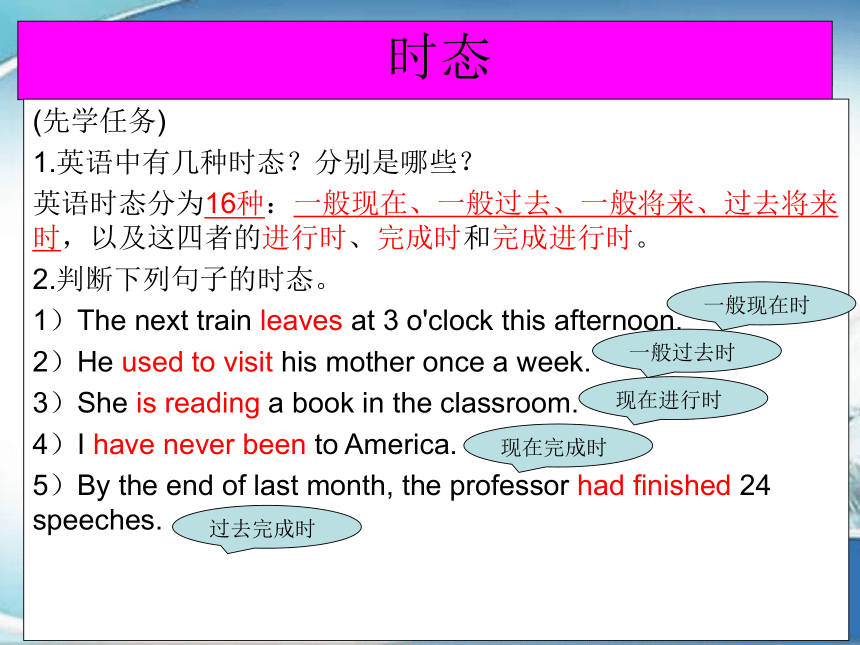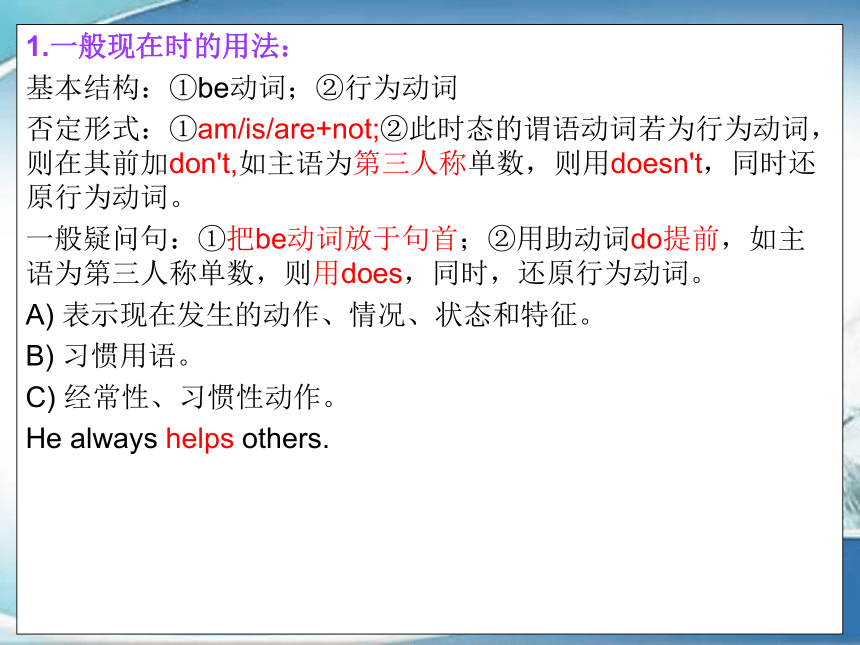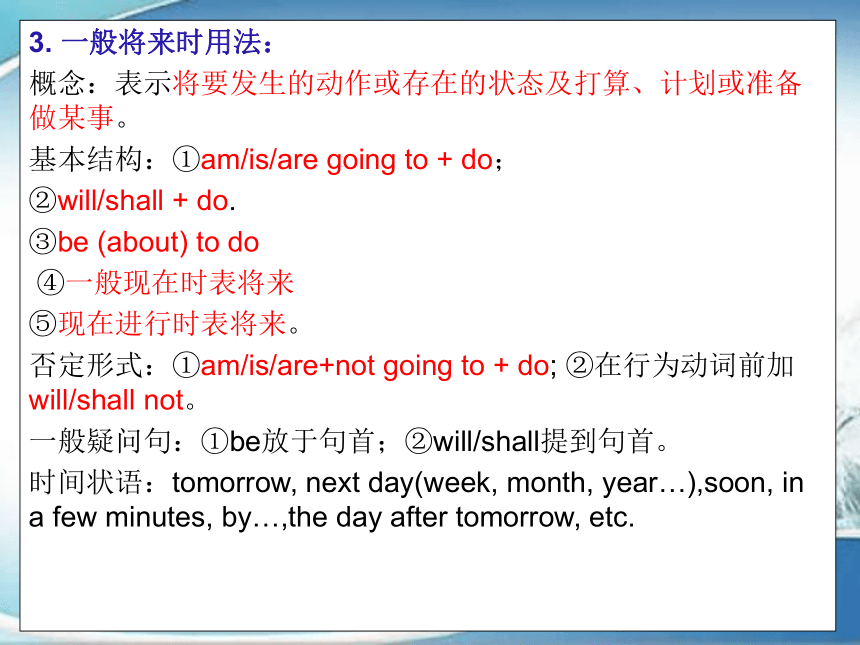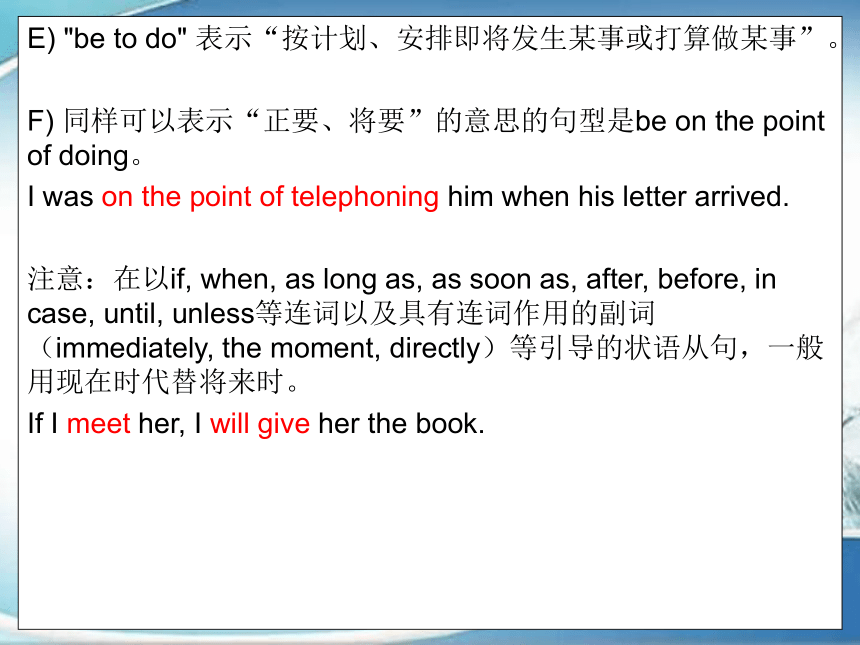中考英语复习课件— 时态讲解及练习(16种含答案)
文档属性
| 名称 | 中考英语复习课件— 时态讲解及练习(16种含答案) |  | |
| 格式 | zip | ||
| 文件大小 | 415.6KB | ||
| 资源类型 | 教案 | ||
| 版本资源 | 人教新目标(Go for it)版 | ||
| 科目 | 英语 | ||
| 更新时间 | 2021-01-01 12:08:10 | ||
图片预览









文档简介
(共22张PPT)
时态
(先学任务)
1.英语中有几种时态?分别是哪些?
英语时态分为16种:一般现在、一般过去、一般将来、过去将来时,以及这四者的进行时、完成时和完成进行时。
2.判断下列句子的时态。
1)The
next
train
leaves
at
3
o'clock
this
afternoon.
2)He
used
to
visit
his
mother
once
a
week.
3)She
is
reading
a
book
in
the
classroom.
4)I
have
never
been
to
America.
5)By
the
end
of
last
month,
the
professor
had
finished
24
speeches.
一般现在时
一般过去时
现在进行时
现在完成时
过去完成时
T:“What’s
the
weather
like
today?”
S:“It
is
cloudy.”
……
Question:
What’s
the
tense
of
this
sentence?(什么是时态?)
时态(Tense)是表示行为、动作和状态在各种时间条件下的动词形式。因此,当我们说时态结构的时候,指的是相应时态下的动词形式。
Step1:
warming
up
&
lead
in
Step2:
时态的分类
1.一般现在时的用法:
基本结构:①be动词;②行为动词
否定形式:①am/is/are+not;②此时态的谓语动词若为行为动词,则在其前加don't,如主语为第三人称单数,则用doesn't,同时还原行为动词。
一般疑问句:①把be动词放于句首;②用助动词do提前,如主语为第三人称单数,则用does,同时,还原行为动词。
A)
表示现在发生的动作、情况、状态和特征。
B)
习惯用语。
C)
经常性、习惯性动作。
He
always
helps
others.
D)
客观事实和普遍真理。尤其要注意,如果前后文不是一般现在时,则无法保持主句、从句时态一致。
The
earth
goes
around
the
sun.
E)
表示一个按规定、计划或安排要发生的动作,(仅限于某些表示“来、去、动、停、开始、结束、继续”等的动词)可以与表示未来时间的状语搭配使用。常见的用法是:飞机、火车、轮船、汽车等定期定点运行的交通方式。
The
next
train
leaves
at
3
o'clock
this
afternoon.
How
often
does
this
bus
run?
(这班车多久一趟?)
F)
在时间和条件状语从句里经常用一般现在表示将来事情。
When
I
see
her,
I
will
tell
her
the
fact.
2.
一般过去时用法:
基本结构:①be动词;②行为动词
否定形式:①was/were+not;②在行为动词前加didn't,同时还原行为动词。
一般疑问句:①was或were放于句首;②用助动词do的过去式did提问,同时还原行为动词。
时间状语:ago,
yesterday,
the
day
before
yesterday,
last
week(year,
night,
month…),
in
1989,
just
now,
at
the
age
of
5,
one
day,
long
long
ago,
once
upon
a
time,
etc.
A)?表示过去某个时间发生的动作或情况。
I
met
her
in
the
hospital
yesterday.
B)?表示过去习惯性动作。特别是由would/
used
to
do表达的句型,本身表示的就是过去时。
He
used
to
visit
his
mother
once
a
week.
3.
一般将来时用法:
概念:表示将要发生的动作或存在的状态及打算、计划或准备做某事。
基本结构:①am/is/are
going
to
+
do;
②will/shall
+
do.
③be
(about)
to
do?
?④一般现在时表将来???
⑤现在进行时表将来。
否定形式:①am/is/are+not
going
to
+
do;?②在行为动词前加will/shall
not。
一般疑问句:①be放于句首;②will/shall提到句首。
时间状语:tomorrow,
next
day(week,
month,
year…),soon,
in
a
few
minutes,
by…,the
day
after
tomorrow,
etc.
A)?基本结构是will
/
shall
do。
We
shall
send
her
a
present
as
her
birthday
gift.
B)?有些动词,如:arrive,
be
close,
come,
do,
done,
go,
have,
leave,
open,
play,
return,
sleep,
start,
stay等,用于现在进行时,并且通常与一个表示将来时间的时间状语连用,可以表示将来时。
My
mother
is
coming
to
visit
me
next
week
and
is
staying
here
until
May.
C)?表示“打算去……,要……”时,可用be
going
to
do。
This
is
just
what
I
am
going
to
say.
D)?表示“即将、正要”时,可用be
about
to
do。强调近期内或马上要做的事。
Don't
worry,
I
am
about
to
make
a
close
examination
on
you.
E)
"be
to
do"?表示“按计划、安排即将发生某事或打算做某事”。
F)?同样可以表示“正要、将要”的意思的句型是be
on
the
point
of
doing。???????
I
was
on
the
point
of
telephoning
him
when
his
letter
arrived.
注意:在以if,
when,
as
long
as,
as
soon
as,
after,
before,
in
case,
until,
unless等连词以及具有连词作用的副词(immediately,
the
moment,
directly)等引导的状语从句,一般用现在时代替将来时。
If
I
meet
her,
I
will
give
her
the
book.
4.过去将来时用法:
概念:立足于过去某一时刻,从过去看将来,常用于宾语从句中。
时间状语:the
next
day(morning,
year…),the
following
month(week…),etc.
基本结构:①was/were/going
to
+
do;②would/should
+
do.
否定形式:①was/were/not
+
going
to
+
do;②would/should
+
not
+
do.
一般疑问句:①was或were放于句首;②would/should提到句首。
?I
said
on
Thursday
I
should
see
my
friend
the
next
day.
(我星期四说我将于第二天拜访我的朋友。)
5.
现在进行时用法:
概念:表示现阶段或说话时正在进行的动作及行为。
时间状语:now,
at
this
time,
these
days,
etc.
基本结构:am/is/are+doing
否定形式:am/is/are+not+doing.
一般疑问句:把be动词放于句首。
——What
are
you
doing
now?
——I
am
making
a
model
ship.
6.
过去进行时用法:
基本结构:was/were+doing
否定形式:was/were
+
not
+
doing.
一般疑问句:把was或were放于句首。
时间状语:at
this
time
yesterday,
at
that
time或以when引导的谓语动词是一般过去时的时间状语等。
A)?表示在过去一个比较具体的时间正在发生的动作。
Mary
was
listening
to
light
music
10
minutes
ago.
(10分钟前,玛丽正在听轻音乐。)
B)?如果when,
while这样的时间状语引导词所引导的主从句之一是一般过去时,则另一个句子常用过去进行时。
I
was
washing
my
hair
when
you
knocked
at
the
front
door.
(你敲前门时我正在洗头发。)
7.
将来进行时用法:
概念:强调在将来的某个具体时间正在发生的动作或事情。
结构:will/shall+be+doing
Don't
worry,
you
won't
miss
her.
She
will
be
wearing
a
red
T-shirt
and
a
white
skirt
at
that
time.(别担心,你不会认不出她的。她到时会穿一件红色的T恤衫和一条白色的短裙。)
注意:由于本时态是由将来时和进行时融合在一起的,所以关于本时态的注意事项,可参考"一般将来时"和"现在进行时"的有关注意事项。
8.
过去将来进行时用法:
结构:should
be
doing
,
would
be
doing
The
government
promised
that
a
new
highway
would
be
being
built
next
July.
(政府承诺说第二年7月将有一条新的高速公路正在修建。)
9.
现在完成时用法:
基本结构:have/has
+
done.
否定形式:have/has
+
not
+done.
一般疑问句:have或has提前。
时间状语:recently,
lately,
since…for…,in
the
past
few
years,
etc.
A)?表示动作到现在为止已经完成或刚刚完成。
The
writer
has
finished
his
novel
and
prepares
to
publish
it.
B)?表示从过去某时刻开始,持续到现在的动作或情况,并且有可能会继续延续下去。此时经常用延续性动词。时间状语常用since加一个过去的时间点,或for加一段时间,或by加一个现在时间。
The
old
lady
has
learned
English
for
ten
years.
注意:现在完成时是联系过去和现在的纽带。现在完成时和过去时的区别在于:现在完成时强调动作的动态,或受动态的影响,是动态的结果,对现在有影响;过去时只表示过去的某个具体时间里发生的动作,与现在没有联系。
I
bought
a
new
house,but
I
haven't
sold
my
old
one
yet,so
at
the
moment
I
have
two
houses.
John
has
broken
his
left
leg.
比较:He
worked
in
that
hospital
for
8
years.
He
has
worked
in
that
hospital
for
8
years.
10.过去完成时用法:
概念:表示在过去的某个时间或动作以前已经发生的动作或已经存在的状态。就是我们常说的:表示"过去的过去的动作或状态"。
基本结构:had
+
done.
否定形式:had
+
not
+
done.
一般疑问句:had放于句首
时间状语:before,
by
the
end
of
last
year(term,
month…),etc.
Until
then,
his
family
hadn't
heard
from
him
for
six
months.
There
had
been
some
one
in
our
room
just
now,
because
I
noticed
a
burning
cigarette
end
on
the
floor
when
we
opened
the
front
door.(刚才有人在我们的房间里,因为我们打开前门进来时,我注意到地板上有一支仍在燃烧的香烟。)
11.
将来完成时用法:
概念:表示从将来的某一时间开始、延续到另一个将来时间的动作或状态,或是发生在某个将来时间,但对其后的另一个将来时间有影响的动作或状态。
结构:will/shall+have+done
The
conference
will
have
lasted
a
full
week
by
the
time
it
ends.
注意:由于本时态是由将来时和完成时融合在一起的,所以关于本时态的注意事项,可以参考“一般将来时”和“现在完成时”的有关注意事项。
12.
过去将来完成时用法:
结构:should
have
done
,
would
have
done
I
believed
by
the
end
of
that
year
an
advanced
version
of
that
software
would
have
been
developed,
but
I
was
wrong.
(我坚信到那年年底为止,那个软件的新版本将被开发出来。但是我错了。)
13.
现在完成进行时用法:
概念:表示某一动作开始于过去某一时间,延续或重复地出现至今,或将继续延续至将来。
结构:(have
been
doing)
We
have
been
working
on
this
project
for
over
a
month
now.
(到目前为止,我们一直在处理那个项目,已经花了一个多月时间了。)
注意:与现在完成时相比,现在完成进行时更强调:在从过去到现在的时间里,动作或状态一直持续或一直反复出现。
14.
过去完成进行时用法:
结构:had
been
doing
The
old
clock
had
been
being
taken
apart
of
and
fixed
up
again
for
several
times
by
my
10-year
old
son
before
I
came
back
home.
(我回到家之前,我10岁大的儿子已经把这个旧钟表拆卸并重新组装了好几回了。)
15.
将来完成进行时用法:
结构:shall
have
been
doing
,will
have
been
doing
By
the
end
of
next
month,
the
project
will
have
been
being
worked
for
3
years.
(到下个月底为止,这项工程就已经不停地进行了3年了。)
16.
过去将来完成进行时用法:
结构:should
have
been
doing
,
would
have
been
doing
They
said
that
by
the
end
of
the
following
month,
the
project
would
have
been
being
worked
for
3
years.
(他们说到第二个月底为止,这项工程就已经不停地进行了3年了。)
翻译下列句子。
1)她父亲去过北京。
__________________________________________________
2)你什么时候开始学俄语的?两年前。
__________________________________________________
3)从中学开始,我们就彼此认识了。
__________________________________________________
4)我不知道他们什么时候去南京。
__________________________________________________
Step3:
当堂导练
Her
father
has
been
to
Beijing.
When
did
you
begin
to
study
Russian?
I
began
to
study
Russian
Two
years
ago.
We
have
known
each
other
since
we
entered
middle
school.
I
wonder
when
they
will
leave
for
Nanjing.
Finish
the
exercises
on
the
learning
plan.
I.
Reference:
1.have,finished
2.goes
3.have,
found
4.is
5.playing
6.were
reading
7.is
climbing
8.will
come
9.do,
get
10.
Have,
seen
II.REFERENCES:1.has
been
2.does
not
play
3.has,
met
4.will
be,
come
5.has,
been
living
6.were
writing
7.are
playing
8.went,
see,met,talked,were
9.had
10.broke,took
11.talking,to
listen
12.to
close
13.go
14.to
help,
clean
15.has
been
teaching
Step4:自辅落实
时态
(先学任务)
1.英语中有几种时态?分别是哪些?
英语时态分为16种:一般现在、一般过去、一般将来、过去将来时,以及这四者的进行时、完成时和完成进行时。
2.判断下列句子的时态。
1)The
next
train
leaves
at
3
o'clock
this
afternoon.
2)He
used
to
visit
his
mother
once
a
week.
3)She
is
reading
a
book
in
the
classroom.
4)I
have
never
been
to
America.
5)By
the
end
of
last
month,
the
professor
had
finished
24
speeches.
一般现在时
一般过去时
现在进行时
现在完成时
过去完成时
T:“What’s
the
weather
like
today?”
S:“It
is
cloudy.”
……
Question:
What’s
the
tense
of
this
sentence?(什么是时态?)
时态(Tense)是表示行为、动作和状态在各种时间条件下的动词形式。因此,当我们说时态结构的时候,指的是相应时态下的动词形式。
Step1:
warming
up
&
lead
in
Step2:
时态的分类
1.一般现在时的用法:
基本结构:①be动词;②行为动词
否定形式:①am/is/are+not;②此时态的谓语动词若为行为动词,则在其前加don't,如主语为第三人称单数,则用doesn't,同时还原行为动词。
一般疑问句:①把be动词放于句首;②用助动词do提前,如主语为第三人称单数,则用does,同时,还原行为动词。
A)
表示现在发生的动作、情况、状态和特征。
B)
习惯用语。
C)
经常性、习惯性动作。
He
always
helps
others.
D)
客观事实和普遍真理。尤其要注意,如果前后文不是一般现在时,则无法保持主句、从句时态一致。
The
earth
goes
around
the
sun.
E)
表示一个按规定、计划或安排要发生的动作,(仅限于某些表示“来、去、动、停、开始、结束、继续”等的动词)可以与表示未来时间的状语搭配使用。常见的用法是:飞机、火车、轮船、汽车等定期定点运行的交通方式。
The
next
train
leaves
at
3
o'clock
this
afternoon.
How
often
does
this
bus
run?
(这班车多久一趟?)
F)
在时间和条件状语从句里经常用一般现在表示将来事情。
When
I
see
her,
I
will
tell
her
the
fact.
2.
一般过去时用法:
基本结构:①be动词;②行为动词
否定形式:①was/were+not;②在行为动词前加didn't,同时还原行为动词。
一般疑问句:①was或were放于句首;②用助动词do的过去式did提问,同时还原行为动词。
时间状语:ago,
yesterday,
the
day
before
yesterday,
last
week(year,
night,
month…),
in
1989,
just
now,
at
the
age
of
5,
one
day,
long
long
ago,
once
upon
a
time,
etc.
A)?表示过去某个时间发生的动作或情况。
I
met
her
in
the
hospital
yesterday.
B)?表示过去习惯性动作。特别是由would/
used
to
do表达的句型,本身表示的就是过去时。
He
used
to
visit
his
mother
once
a
week.
3.
一般将来时用法:
概念:表示将要发生的动作或存在的状态及打算、计划或准备做某事。
基本结构:①am/is/are
going
to
+
do;
②will/shall
+
do.
③be
(about)
to
do?
?④一般现在时表将来???
⑤现在进行时表将来。
否定形式:①am/is/are+not
going
to
+
do;?②在行为动词前加will/shall
not。
一般疑问句:①be放于句首;②will/shall提到句首。
时间状语:tomorrow,
next
day(week,
month,
year…),soon,
in
a
few
minutes,
by…,the
day
after
tomorrow,
etc.
A)?基本结构是will
/
shall
do。
We
shall
send
her
a
present
as
her
birthday
gift.
B)?有些动词,如:arrive,
be
close,
come,
do,
done,
go,
have,
leave,
open,
play,
return,
sleep,
start,
stay等,用于现在进行时,并且通常与一个表示将来时间的时间状语连用,可以表示将来时。
My
mother
is
coming
to
visit
me
next
week
and
is
staying
here
until
May.
C)?表示“打算去……,要……”时,可用be
going
to
do。
This
is
just
what
I
am
going
to
say.
D)?表示“即将、正要”时,可用be
about
to
do。强调近期内或马上要做的事。
Don't
worry,
I
am
about
to
make
a
close
examination
on
you.
E)
"be
to
do"?表示“按计划、安排即将发生某事或打算做某事”。
F)?同样可以表示“正要、将要”的意思的句型是be
on
the
point
of
doing。???????
I
was
on
the
point
of
telephoning
him
when
his
letter
arrived.
注意:在以if,
when,
as
long
as,
as
soon
as,
after,
before,
in
case,
until,
unless等连词以及具有连词作用的副词(immediately,
the
moment,
directly)等引导的状语从句,一般用现在时代替将来时。
If
I
meet
her,
I
will
give
her
the
book.
4.过去将来时用法:
概念:立足于过去某一时刻,从过去看将来,常用于宾语从句中。
时间状语:the
next
day(morning,
year…),the
following
month(week…),etc.
基本结构:①was/were/going
to
+
do;②would/should
+
do.
否定形式:①was/were/not
+
going
to
+
do;②would/should
+
not
+
do.
一般疑问句:①was或were放于句首;②would/should提到句首。
?I
said
on
Thursday
I
should
see
my
friend
the
next
day.
(我星期四说我将于第二天拜访我的朋友。)
5.
现在进行时用法:
概念:表示现阶段或说话时正在进行的动作及行为。
时间状语:now,
at
this
time,
these
days,
etc.
基本结构:am/is/are+doing
否定形式:am/is/are+not+doing.
一般疑问句:把be动词放于句首。
——What
are
you
doing
now?
——I
am
making
a
model
ship.
6.
过去进行时用法:
基本结构:was/were+doing
否定形式:was/were
+
not
+
doing.
一般疑问句:把was或were放于句首。
时间状语:at
this
time
yesterday,
at
that
time或以when引导的谓语动词是一般过去时的时间状语等。
A)?表示在过去一个比较具体的时间正在发生的动作。
Mary
was
listening
to
light
music
10
minutes
ago.
(10分钟前,玛丽正在听轻音乐。)
B)?如果when,
while这样的时间状语引导词所引导的主从句之一是一般过去时,则另一个句子常用过去进行时。
I
was
washing
my
hair
when
you
knocked
at
the
front
door.
(你敲前门时我正在洗头发。)
7.
将来进行时用法:
概念:强调在将来的某个具体时间正在发生的动作或事情。
结构:will/shall+be+doing
Don't
worry,
you
won't
miss
her.
She
will
be
wearing
a
red
T-shirt
and
a
white
skirt
at
that
time.(别担心,你不会认不出她的。她到时会穿一件红色的T恤衫和一条白色的短裙。)
注意:由于本时态是由将来时和进行时融合在一起的,所以关于本时态的注意事项,可参考"一般将来时"和"现在进行时"的有关注意事项。
8.
过去将来进行时用法:
结构:should
be
doing
,
would
be
doing
The
government
promised
that
a
new
highway
would
be
being
built
next
July.
(政府承诺说第二年7月将有一条新的高速公路正在修建。)
9.
现在完成时用法:
基本结构:have/has
+
done.
否定形式:have/has
+
not
+done.
一般疑问句:have或has提前。
时间状语:recently,
lately,
since…for…,in
the
past
few
years,
etc.
A)?表示动作到现在为止已经完成或刚刚完成。
The
writer
has
finished
his
novel
and
prepares
to
publish
it.
B)?表示从过去某时刻开始,持续到现在的动作或情况,并且有可能会继续延续下去。此时经常用延续性动词。时间状语常用since加一个过去的时间点,或for加一段时间,或by加一个现在时间。
The
old
lady
has
learned
English
for
ten
years.
注意:现在完成时是联系过去和现在的纽带。现在完成时和过去时的区别在于:现在完成时强调动作的动态,或受动态的影响,是动态的结果,对现在有影响;过去时只表示过去的某个具体时间里发生的动作,与现在没有联系。
I
bought
a
new
house,but
I
haven't
sold
my
old
one
yet,so
at
the
moment
I
have
two
houses.
John
has
broken
his
left
leg.
比较:He
worked
in
that
hospital
for
8
years.
He
has
worked
in
that
hospital
for
8
years.
10.过去完成时用法:
概念:表示在过去的某个时间或动作以前已经发生的动作或已经存在的状态。就是我们常说的:表示"过去的过去的动作或状态"。
基本结构:had
+
done.
否定形式:had
+
not
+
done.
一般疑问句:had放于句首
时间状语:before,
by
the
end
of
last
year(term,
month…),etc.
Until
then,
his
family
hadn't
heard
from
him
for
six
months.
There
had
been
some
one
in
our
room
just
now,
because
I
noticed
a
burning
cigarette
end
on
the
floor
when
we
opened
the
front
door.(刚才有人在我们的房间里,因为我们打开前门进来时,我注意到地板上有一支仍在燃烧的香烟。)
11.
将来完成时用法:
概念:表示从将来的某一时间开始、延续到另一个将来时间的动作或状态,或是发生在某个将来时间,但对其后的另一个将来时间有影响的动作或状态。
结构:will/shall+have+done
The
conference
will
have
lasted
a
full
week
by
the
time
it
ends.
注意:由于本时态是由将来时和完成时融合在一起的,所以关于本时态的注意事项,可以参考“一般将来时”和“现在完成时”的有关注意事项。
12.
过去将来完成时用法:
结构:should
have
done
,
would
have
done
I
believed
by
the
end
of
that
year
an
advanced
version
of
that
software
would
have
been
developed,
but
I
was
wrong.
(我坚信到那年年底为止,那个软件的新版本将被开发出来。但是我错了。)
13.
现在完成进行时用法:
概念:表示某一动作开始于过去某一时间,延续或重复地出现至今,或将继续延续至将来。
结构:(have
been
doing)
We
have
been
working
on
this
project
for
over
a
month
now.
(到目前为止,我们一直在处理那个项目,已经花了一个多月时间了。)
注意:与现在完成时相比,现在完成进行时更强调:在从过去到现在的时间里,动作或状态一直持续或一直反复出现。
14.
过去完成进行时用法:
结构:had
been
doing
The
old
clock
had
been
being
taken
apart
of
and
fixed
up
again
for
several
times
by
my
10-year
old
son
before
I
came
back
home.
(我回到家之前,我10岁大的儿子已经把这个旧钟表拆卸并重新组装了好几回了。)
15.
将来完成进行时用法:
结构:shall
have
been
doing
,will
have
been
doing
By
the
end
of
next
month,
the
project
will
have
been
being
worked
for
3
years.
(到下个月底为止,这项工程就已经不停地进行了3年了。)
16.
过去将来完成进行时用法:
结构:should
have
been
doing
,
would
have
been
doing
They
said
that
by
the
end
of
the
following
month,
the
project
would
have
been
being
worked
for
3
years.
(他们说到第二个月底为止,这项工程就已经不停地进行了3年了。)
翻译下列句子。
1)她父亲去过北京。
__________________________________________________
2)你什么时候开始学俄语的?两年前。
__________________________________________________
3)从中学开始,我们就彼此认识了。
__________________________________________________
4)我不知道他们什么时候去南京。
__________________________________________________
Step3:
当堂导练
Her
father
has
been
to
Beijing.
When
did
you
begin
to
study
Russian?
I
began
to
study
Russian
Two
years
ago.
We
have
known
each
other
since
we
entered
middle
school.
I
wonder
when
they
will
leave
for
Nanjing.
Finish
the
exercises
on
the
learning
plan.
I.
Reference:
1.have,finished
2.goes
3.have,
found
4.is
5.playing
6.were
reading
7.is
climbing
8.will
come
9.do,
get
10.
Have,
seen
II.REFERENCES:1.has
been
2.does
not
play
3.has,
met
4.will
be,
come
5.has,
been
living
6.were
writing
7.are
playing
8.went,
see,met,talked,were
9.had
10.broke,took
11.talking,to
listen
12.to
close
13.go
14.to
help,
clean
15.has
been
teaching
Step4:自辅落实
同课章节目录
- 词法
- 名词
- 动词和动词短语
- 动词语态
- 动词时态
- 助动词和情态动词
- 非谓语动词
- 冠词
- 代词
- 数词和量词
- 形容词副词及其比较等级
- 介词和介词短语
- 连词和感叹词
- 构词法
- 相似、相近词比较
- 句法
- 陈述句
- 一般疑问句和否定疑问句
- 特殊疑问句及选择疑问句
- 反意疑问句
- 存在句(There be句型)
- 宾语从句
- 定语从句
- 状语从句
- 主谓一致问题
- 简单句
- 并列句
- 复合句
- 主谓一致
- 主、表语从句
- 名词性从句
- 直接引语和间接引语
- 虚拟语气
- 感叹句
- 强调句
- 倒装句
- 祈使句
- 句子的成分
- 句子的分类
- 题型专区
- 单项选择部分
- 易错题
- 完形填空
- 阅读理解
- 词汇练习
- 听说训练
- 句型转换
- 补全对话
- 短文改错
- 翻译
- 书面表达
- 任务型阅读
- 语法填空
- 其他资料
